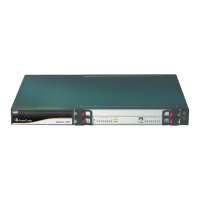Version 7.0 533 Mediant 3000
User's Manual 27. Configuring Supplementary Services
27.6 Multilevel Precedence and Preemption
The device supports Multilevel Precedence and Preemption (MLPP) service. MLPP is a
call priority scheme, which does the following:
Assigns a precedence level (priority level) to specific phone calls or messages.
Allows higher priority calls (precedence call) and messages to preempt lower priority
calls and messages (i.e., terminates existing lower priority calls) that are recognized
within a user-defined domain (MLPP domain ID). The domain specifies the collection
of devices and resources that are associated with an MLPP subscriber. When an
MLPP subscriber that belongs to a particular domain places a precedence call to
another MLPP subscriber that belongs to the same domain, MLPP service can
preempt the existing call that the called MLPP subscriber is on for a higher-
precedence call. MLPP service availability does not apply across different domains.
MLPP is typically used in the military where, for example, high-ranking personnel can
preempt active calls during network stress scenarios such as a national emergency or
degraded network situations.
MLPP can be enabled for all calls, using the global parameter, CallPriorityMode, or for
specific calls using the Tel Profile parameter, CallPriorityMode.
Notes:
• MLPP is supported on ISDN PRI interfaces.
• The device provides MLPP interworking between SIP and ISDN (both directions).
• For Trunk Groups configured with call preemption, all must be configured to MLPP
[1] or all configured to Emergency [2]. In other words, you cannot set some trunks
to [1] and some to [2].
• The global parameter must be set to the same value as that of the Tel Profile
parameter; otherwise, the Tel Profile parameter is not applied.
• If you configure call preemption using the global parameter and a new Tel Profile
is subsequently added, the TelProfile_CallPriorityMode parameter automatically
acquires the same setting as well.
The Resource Priority value in the Resource-Priority SIP header can be any one of those
listed in the table below. A default MLPP call Precedence Level (configured by the
SIPDefaultCallPriority parameter) is used if the incoming SIP INVITE or PRI Setup
message contains an invalid priority or Precedence Level value respectively. For each
MLPP call priority level, the Multiple Differentiated Services Code Points (DSCP) can be
set to a value from 0 to 63.
Table 27-1: MLPP Call Priority Levels (Precedence) and DSCP Configuration Parameters
MLPP Precedence Level Precedence Level in Resource-
Priority SIP Header
DSCP Configuration Parameter
0 (lowest) routine MLPPRoutineRTPDSCP
2 priority MLPPPriorityRTPDSCP
4 immediate MLPPImmediateRTPDSCP
6 flash MLPPFlashRTPDSCP
8 flash-override MLPPFlashOverRTPDSCP
9 (highest) flash-override-override MLPPFlashOverOverRTPDSCP

